November 29 - 30, 2002
has a view to an Indian Fortress and volcanic plains of Lava Beds
| Hippo Butte November 29 - 30, 2002 has a view to an Indian Fortress and volcanic plains of Lava Beds |
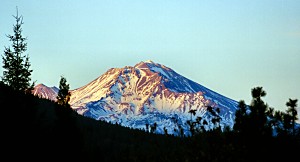 |
||
| Mt Shasta dominated our horizon throughout our whole trip |
Four days off at Thanksgiving is naturally a very suitable opportunity to take Hippo out. It may seem that we have already seen everything in California, but the opposite is true. As it was, we found out that I had personally never visited Hippo Butte. Simply a scandal.
Hippo Butte is found in Lava Beds National Monument, which hides somewhere between Oregon border and Lassen NP. Since it is not a National Park, we supposed that we'd meet a minimum number of tourists there. Still we did not leave things to fortune and made sure to arrange a hotel room in Klamath Falls, to avoid our disappointment of last year's.
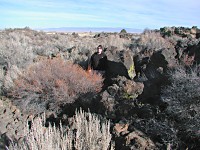 |
||
| Modoc Fortress even Hippo can blend into this difficult terrain, no wonder that Modoc Indians could resist federal army so long here. |
Klamath Falls is a small city in Oregon, known by logging industry, controversy between farmers and state-employed eco-terrorists about water from Klamath Lake. The city's name is somewhat absurd, as the town itself is located in relatively flat basin. So I wondered, where those falls would be. Only during our recent visit we learned that the town used to be Linkville, but once it became the seat of county government, city council began to look for a more attractive name. "Falls" sounded attractive enough, and Klamath is a name of a local Indian tribe. There really were no waterfalls anywhere near, besides a little step on a river, drowned within a reservoir created by a dam of modern days, but the name sounded really attractive. Nearest real falls can be found near Crater Lake, some 60 miles north.
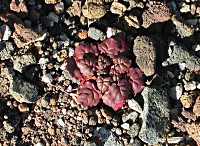 |
||
| Life thrives in midst of ashes and pumice |
Well, is it not a cute story? However, we encountered similar attitude at the paper hut that someone decided to call a hotel. At Holiday Inn Express, we met with a nice receptionist, soaked ourselves in their hot tub and pool, simply idyllic. It got much worse later, though, when we attempted to fall asleep in our assigned room, with a worn-out fan in our neighbor's bathroom running wild through the whole night. At 3 a.m., still not able to sleep, we had enough and demanded a different room. We got it, but there we noticed that another neighbor had a prostate problem, or perhaps that ventilation fan could be heard through sound conduits in every single room there was. In addition, we received entertainment in the form of Mexican folklore music (its quality and artistic extremes of singers in their "best years" strongly remind of Czech wind blowing music). Morning found us in a mightily deprived state.
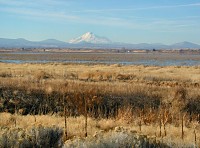 |
||
| Sorras Lake with an ubiquitous Shasta in background. Right in the middle, a mule deer peeks out of the reeks |
We cancelled our original reservation for the next night, as we would certainly be able to get lodging of this quality at half the price at any Bombay Star Motel. A frosty, crisp and sunny day awaited us outside. This is somewhat unusual in our climate, hence we did not let our miserable night in miserable Holiday Inn spoil it any more -- putting on fuzzy coats, we ran out to enjoy this (for us) exotic weather.
Lava Beds are very peculiar piece of landscape. The whole California is quite volcanic, but many such phenomena are concentrated in Lava Beds on one spot. First, there are huge lava fields. They look a little like a surface coal mine, or freshly plowed lowland fields, only a little out of scale, and very hard and compact. Solidified lava creates various formations, ancient lava flow conduits had formed tubular caves and miscellaneous sinks and "traps". One tiny hill has it all combined so usefully that in this natural fortress, Indians of the Modoc tribe under the command of Captain Jack resisted while outnumbered by a federal army, for several months.
 |
||
| Hippo on Hippo Butte |
During white settlement of Northern California and Southern Oregon, original Indian population was a source of controversies. While Klamath tribe was allotted more or less exactly the same land they were interested in, and so conflicts were avoided, Modocs were to be moved from their lake (Sorras Lake, CA) into an area already controlled by Klamaths (Oregon). Disputes between individual tribes led to a part of Modocs returning to their original location. History gets complicated here -- first, Indians themselves were not internally united, and neither were white men (across two states). A war raged for several months and culminated in execution of Captain Jack. The whole story is a lengthy, confusing, and very sad. If you're interested in details, an interesting account can be found here.
From the "fortress" we headed towards lava fields and then to an information center. Hippo demanded a visit to lava tubes, and we wanted to get some maps and instructions. It surprised us that the nearest cave open to public had an entrance right in the middle of a parking lot at the tourist center. Since this one was properly illuminated by fluorescent tubes and thoroughly "touristed", it seemed to be a bearable attraction, despite my claustrophobia. I felt a little like in a subway tunnel, which I know by heart and in which I'm not afraid. Ancient molten lava solidified here, starting with the part exposed to air, and so many streams continued flowing under an already rigid surface, creating tubes in rock. Eventually all liquid content either solidified or flowed out, leaving behind a tubular shell. There are several dozens of such caves in the vicinity, the information center provides guides for seventeen of them, about their length and access difficulty -- the easiest ones can be walked through, others require crawling, bending down, and climbing; some have irregular floors and similar (for me) unreasonable improvements. Fortunately Sid got satisfied by visiting our parking lot Mushpot Cave, which turned out to be more entertaining than we had expected, being equipped with interpretive signs and illuminated spots of interest.
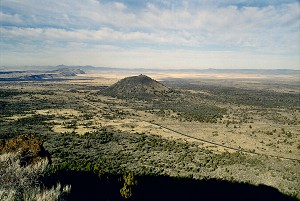 |
||
| Lava Beds with cindercone in foreground, spilled lava on the left, and an edge of a fault. |
Nevertheless, we came to visit Lava Bed especially for one attraction that's above ground, the Hippo Butte (5,500 ft). It's a cindercone made of volcanic rock. These cones get created when magma squirts from a crack in bedrock and molten rock "rains" back on one spot. A cindercone is - unlike a volcano - active only once. Thanks to a twin crater, Hippo Butte looks from a distance a little like a hippo head emerging from a lake. To hike on top is somewhat harder than it looks. There's no trail and a heap of ashes and funny, light pumice (if you throw this "rock" in water, it often stays floating on surface), rolls and shifts under your every step, so you make two steps up, and you slide one step back.
From a rim of the crater, the landscape looks like an illustration in a geology textbook. Besides lava fields, caves, craters, spills, more cindercones and Mt. Shasta on the horizon, one can clearly see a tectonic fault -- three giant steps running into the distance. Visibility in a frosty, dry air was many tens of miles at least. Add an absence of any tourists, you get a hell of a romantic setup. Early winter sunset was approaching and we were being forced to make a decision. Should we drive back to Klamath Falls, wondering what to do with the rest of the evening (it was about 5 p.m.), with the outlook to traffic jams around Sacramento and San Francisco on the following day -- or hop in our wagon, drive through a part of the night and end up sleeping comfortably in our new bed? Well, try to guess...
| Copyright © 2002-2005 by Carol & Sid Paral. All rights reserved. |